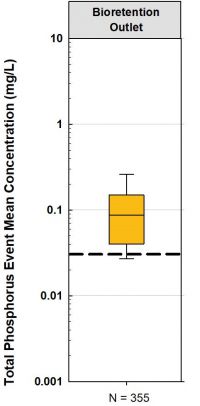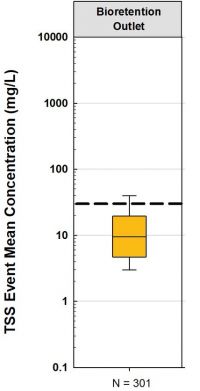Bioretention: Performances
Phosphorus Reduction[edit]
The performance results for Bioretention practices, located within TRCA's watershed originate from three primary sites:
- Kortright Centre
- Earth Rangers
- Seneca College
- Central Parkway (Mississauga)
- Wychwood Subdivision (Brampton)
- IMAX Corporation, head office
The mean performance value recorded at the outlet for Bioretention practices' ability to remove Total Phosphorus (TP) was calculated based on 355 separate recordings between 2005-2007, 2011-2019 and 2021 amongst the six sites previously mentioned.
As can be seen in the corresponding boxplot the mean performance removal efficiency of the bioretention practices monitored are not meeting the acceptable range of nutrients as of 0.035 mg/L (35 µg/L) (Environment Canada, 2004[1]).
TSS Reduction[edit]
The performance results for Bioretention practices, located within TRCA's watershed originate from three primary sites:
- Kortright Centre
- Earth Rangers
- Seneca College
- Central Parkway (Mississauga)
- Wychwood Subdivision (Brampton)
- IMAX Corporation, head office
The mean performance value recorded at the outlet for Bioretention practices' ability to remove Total Phosphorus (TP) was calculated based on 301 separate recordings between 2005-2007, 2011-2019 and 2021 amongst the sixsites previously mentioned.
References[edit]
- ↑ Environment Canada. (2004). Canadian guidance framework for the management of phosphorus in freshwater systems. Ecosystem Health: Science‐based solutions report no. 1–8. Cat. No. En1–34/8–2004E.

